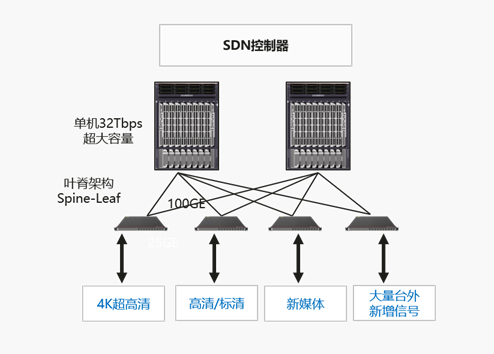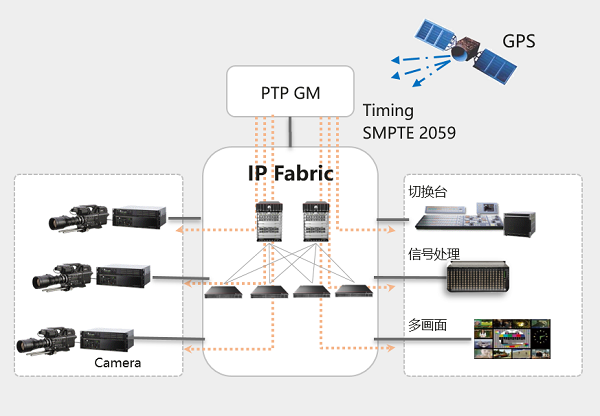Huawei's IP production and broadcasting network solution continues to innovate,

Huawei's IP production and broadcasting network solution continues to innovate, helping TV enter the ultra-high-definition era
Today is World Television Day. Do you remember the last time the whole family enjoyed themselves and watched TV together? Modern people's lives are surrounded by electronic products, and TVs have a new viewing experience. Multiple lenses can realize real-time conversion of 360-degree viewing angles, and 8K ultra-high-definition brings an immersive experience. Television, as a mainstream media tool, has greatly broadened the window of human cognition. In 1996, the United Nations determined that television has made outstanding contributions to global cultural exchanges and information dissemination, and designated November 21 of each year as "World Television Day". .
Has Your DNA Moved About TV?
When Chinese people got married in the 1980s, TV was definitely the most important part of the bride price; in 1986, the Shanghai Animation Film Studio originally produced "The Story of Calabash Baby", which accompanied the childhood growth of the post-80s and post-90s; and in the early morning, Even before the broadcast of the large-scale popular science program "Approaching Science", turn on the TV, and you must have seen the multi-color blocks. In fact, it is a TV test card for checking the working performance of the color decoder. Maybe it is the earliest "heart" plug" experience.
The past and present of television
Looking back at the history of television development over the past century, as early as 1877, French scientist Sunlake used the difference in resistance of selenium to design and manufacture an instrument that transmits images by current, and named it "remote electron microscope". In fact, it was not until 1900 that the term "television" was officially proposed by the British Constantine Persky. The real TV was invented by the British John Baird in 1925. A practical mechanical scanning television device, which realizes the generation of images. The first TV set in my country was a Beijing brand 14-inch black and white TV set independently manufactured by Tianjin Radio Factory in 1958.
Later, with the development of the times, TV technology continued to innovate and break through. The color picture tube added color to the TV screen, and communication enabled TV to realize the live broadcast of the first moon landing by human beings all over the world. In the new millennium, the emergence of digital TV gave TV more The industry brings a new audio-visual experience, and 8K film and television allows light and shadow to shine into reality, bringing the ultimate viewing experience.
What changes will 8K bring to our lives
The three Chinese astronauts on Shenzhou 13 used 8K to shoot the space documentary. In the field of industrial production, 8K can be used to present subtle changes in parts in industrial production. In addition to the fields of film and television, sports, and competitions, 8K also makes telemedicine a reality, and surgical lines that are difficult to distinguish with the naked eye can be clearly presented on 8K. In terms of security, only a small number of cameras can monitor a large area. Another example is in the field of cultural relics protection, 8K can restore the details of cultural relics to the greatest extent and increase the protection of cultural relics.
What is the future of TV production and broadcasting?
TVs have evolved from tubes and transistors to integrated circuits, from black and white to brilliant colors, and from standard definition to high definition, 4K, and 8K. With the widespread application of the new generation of digital technology, television plays a more important role in the media, and the audience's demand for ultra-clear and more immersive experience is increasing day by day. The large-scale development of the TV industry to the ultra-high-definition industry, and the transformation to IP and integrated media have become the general trend. At the same time, the bandwidth and performance requirements of the production and broadcasting system are increasing geometrically.
From knowing to breaking
Traditional TVs use dedicated SDI copper cables. The signal is transmitted in one direction on the SDI copper cable. The current maximum bandwidth of an SDI copper cable is 24G. If you want to transmit an uncompressed 8K signal, you need 48G bandwidth, and the number of cables is at least doubled. It increases the difficulty of deployment, operation and maintenance, and once it is broken, it needs to be replaced. It is too laborious to find the bad cable. Moreover, the SDI copper cable has a short transmission distance, is very thick and heavy, and it is a big problem to carry it alone.
Content is the core asset of video, so uncompressed signals are crucial for 8K. Uncompressed signals require stable bandwidth without bursts, no packet loss during transmission, and support for us-level time synchronization accuracy. These are very important for 8K technology.
Advantages of Huawei's IP-based Solution for Production and Broadcasting
Based on the all-IP solution, network slicing, and high-bandwidth capabilities, Huawei's IP production and broadcasting network solution breaks through the bottleneck of ultra-high-definition production and broadcasting technology. The system is IP-based, realizing the integrated production and broadcasting of collection, editing, broadcasting, storage and transmission, greatly improving the production and broadcasting efficiency, meeting high-quality business requirements, and ensuring the safety, efficiency and reliability of production and broadcasting.
Low cost, more secure: clean video switching, accurate switching of video frames
The matrix has built-in video net switching, which can be cut immediately without loss of picture; no need to double the traffic, saving bandwidth resources; no need for peripheral switching equipment, simplifying the system.
High performance, more efficient: All ports and full wire-speed multicast NAT, realizing thousands of channels of 4K signal bearer
Over 2,000 channels of 4K ultra-high-definition uncompressed signal bearer; on-demand address translation, minimalist system deployment; forwarding performance does not decrease after multicast NAT, and there is no packet loss for large traffic.

Router Leaf-Spine Architecture
High-quality, more reliable: the most precise and stable clock synchronization in the industry, supporting real-time production and broadcast of ultra-high-definition video
Industry-leading Class C clock synchronization accuracy, precise synchronization of picture and sound; unique PTSF patent, ensuring high stability of the business network clock system when the clock source is abnormal.

PTP-based clock synchronization system (4K/8K)
Why Choose Huawei NetEngine Routers
Huawei's IP-based solution for production and broadcasting uses NetEngine 8000 series intelligent routers as the carrier and is applied to all-scenario WAN services to meet various types of network connections. With ultra-high quality, stable and reliable IP matrix is guaranteed, broadcast control and loop avoidance are used to ensure safe production and broadcasting, and large-scale table entry capabilities are used to realize 4K/8K ultra-large-scale unified bearing, which perfectly meets the future evolution needs of production and broadcasting networks .

NetEngine 8000 Series
Huawei has always adhered to the core concept of being customer-centric, combining customer needs with its own R&D capabilities and industry standard influence, and working with customers and partners to support independent innovation, continuous evolution, and continuous incubation of IP-based production and broadcasting services More advanced products and solutions will promote the sustainable development of the UHD industry.